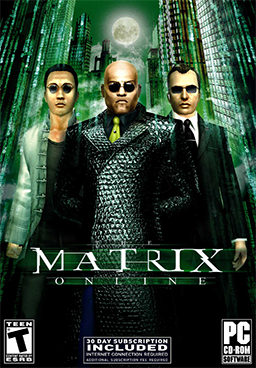Related Research Articles

Nights into Dreams is a 1996 action game developed by Sonic Team and published by Sega for the Sega Saturn. The story follows the teenagers Elliot Edwards and Claris Sinclair, who enter Nightopia, a dream world where all dreams take place. With the help of Nights, an exiled "Nightmaren", they begin a journey to stop the evil ruler Wizeman from destroying Nightopia and consequently the real world. Players control Nights flying through Elliot and Claris's dreams to gather enough energy to defeat Wizeman and save Nightopia. The game is presented in 3D and imposes time limits on every level, in which the player must accumulate points to proceed.
Alpha–beta pruning is a search algorithm that seeks to decrease the number of nodes that are evaluated by the minimax algorithm in its search tree. It is an adversarial search algorithm used commonly for machine playing of two-player combinatorial games. It stops evaluating a move when at least one possibility has been found that proves the move to be worse than a previously examined move. Such moves need not be evaluated further. When applied to a standard minimax tree, it returns the same move as minimax would, but prunes away branches that cannot possibly influence the final decision.

The Matrix Online was a massively multiplayer online role-playing game (MMORPG) initially developed by Monolith Productions and later, a few months after launch, by Sony Online Entertainment. It was advertised as a continuation of the storyline of The Matrix films, as The Wachowskis, the franchise's creators, gave their blessing to the notion of gamers "inherit[ing] the storyline". The game began closed beta-testing in June 2004 which was then opened for people who pre-ordered the game in November 2004. Warner Bros. and Sega released MxO on March 22, 2005 in the United States. It was released in Europe on April 15, 2005. In June, Warner Bros. sold the rights to the game to Sony Online Entertainment, and the game's development and operation was transferred to the latter on August 15, 2005. Sony Online Entertainment shut down operation of the game on July 31, 2009.

Wolfenstein: Enemy Territory is a free and open-source multiplayer first-person shooter video game within the Wolfenstein series. It was originally planned to be released as a commercial expansion pack to Return to Castle Wolfenstein and later as a standalone game. However, due to problems with the single-player aspect, the multiplayer portion was released on 29 May 2003 as a freeware standalone game. In January 2004, the source code for the game logic was released to the benefit of its modding community.

SubSpace is a 2D space shooter video game created in 1995 and released in 1997 by Virgin Interactive which was a finalist for the Academy of Interactive Arts & Sciences Online Game of the Year Award in 1998. SubSpace incorporates quasi-realistic zero-friction physics into a massively multiplayer online game.

Interstellar Pig, published in 1984 by Bantam Books, is a science fiction novel for young adults written by William Sleator. It was listed as an ALA Notable Book, a SLJ Best Book of the Year, and a Junior Literary Guild Selection.

Blast Chamber is a 1996 action puzzle video game developed by Attention to Detail and published by Activision for the PlayStation and Sega Saturn. It was the first non-sports four-player game for the PlayStation and Saturn. A demo was released in 1997 for MS-DOS, but the full version was never published.
Reassembly is a 2D open world space shooter PC game, created by video game developer Anisoptera Games. The game is available on Steam or from the developer's website via Humble Widget. Native versions are available for Microsoft Windows, Mac OS, and Linux. It was released on February 19, 2015.

Pirates, Vikings and Knights II is a multiplayer team-based first-person action video game, developed as a total conversion modification on Valve proprietary Source engine. The game is currently in beta development stages, with its first public release on 1 January 2007. The second major public version was released a year later on 7 February 2008.

Nights: Journey of Dreams is an action video game developed by Sega Studios USA and published by Sega for the Wii. The sequel to the 1996 Sega Saturn title Nights into Dreams, it was released in Japan and North America in December 2007, and in Australia and Europe the following month. The story follows two children, William Taylor and Helen Cartwright, who enter a dream world called Nightopia. When their nightmares come to life, they enlist the help of Nights, an exiled "Nightmaren", as they journey through Nightopia to stop the evil ruler Wizeman from escaping into the real world.

Street Legal Racing Redline is a racing game developed by Invictus and published by Activision Value. The game was released for Windows in July 2003.

MAG was a 2010 massively multiplayer online first-person shooter video game developed by Zipper Interactive and published by Sony Computer Entertainment for the PlayStation 3. MAG received an award from Guinness World Records as "Most Players in a Console FPS" with 256 players.

Star Strike is a single-player video game, released by Mattel for its Intellivision video game system in 1981. The Intellivision's best-selling game in 1982, with over 800,000 copies sold, Star Strike was inspired by the attack on the Death Star in the 1977 film Star Wars. The player must drop bombs on alien weapons silos before Earth moves into range.

MicroVolts is an online multiplayer shooter developed by Korean developer SK iMedia and published by Toronto-based publisher Rock Hippo Productions for Windows (PC). MicroVolts released its first closed beta phase on August 12, 2010 and launched its second closed beta on January 28, 2011. The game's open beta phase began on March 10, 2011. Rock Hippo Productions announced that the official release of the game would start on June 9, 2011. It was shut down on 9. September 2017 9 am GMT and the rights were allegedly sold to Masangsoft.

Diamond Trust of London is a turn-based strategy video game by Jason Rohrer, with music by Tom Bailey. Following a crowdfunding campaign on Kickstarter the game was published by indiePub and released for the Nintendo DS on August 28, 2012. The game has been placed in the public domain and is hosted on SourceForge.

Resident Evil Survivor 2 – Code: Veronica is a light gun shooter video game developed and published by Capcom as part of the Resident Evil series. The arcade version was developed in conjunction with Namco for the arcade machines. The game was released for Sega NAOMI and PlayStation 2. It was released on the PlayStation 2 on November 7, 2002 in Japan and in Europe on March 22, 2002. Whilst the Playstation 2 release is a light gun shooter, the NAOMI arcade release features no lightgun technology whatsoever, instead deferring control of each player entirely to a three-axis joystick in the shape of a gun. The game is the second installment in the Gun Survivor series and the sequel to Resident Evil Survivor. The game is adapted from Resident Evil – Code: Veronica and features enemies and characters from that game, and enemies from Resident Evil 2 and 3. It was followed by Dino Stalker which is a spin-off of Dino Crisis, and has no ties to Resident Evil.

Defense Grid 2 is a 2014 tower defense video game developed by Hidden Path Entertainment and published by 505 Games. As a sequel to the 2008 Defense Grid: The Awakening, the game was crowd-funded on Kickstarter in 2012 and released on Windows, Xbox One, and PlayStation 4 on September 23, 2014. Linux and OS X versions were released on October 15, 2014, and the Nintendo Switch version was released on February 7, 2019.

Hand of Fate is an action role-playing roguelike deck-building game developed and published by Australian studio Defiant Development for Linux, macOS, Microsoft Windows, PlayStation 4, and Xbox One, released via early access on 7 July 2014, and then in the full release on 17 February 2015. A PlayStation Vita version was announced but ultimately cancelled due to development issues.

Police Stories is a 2019 top-down shooter video game developed by Mighty Morgan and published by HypeTrain Digital for Microsoft Windows, macOS, Linux, Nintendo Switch, PlayStation 4, and Xbox One. The game follows a pair of police officers who come upon a major conspiracy.

Spirit Island is a euro-style co-operative strategy board game designed by R. Eric Reuss and published by Greater Than Games in 2017. Digital versions have been released for PC, iOS, and Android.
References
- ↑ "SiSSYFiGHT 2000". www.sissyfight.com. Archived from the original on 7 April 2001. Retrieved 14 January 2022.
- ↑ Katie Salen; Eric Zimmerman (2004). Rules of play: game design fundamentals. MIT Press. ISBN 978-0-262-24045-1 . Retrieved 2 June 2013.
- ↑ honorcode
- ↑ sissyfight-2000-returns on kickstarter.com
- ↑ post on sissyfightboards.com
- ↑ Some-very-sad-news on sissyfightschoolboard.yuku.com
- 1 2 sissyfight license information on github.com
- ↑ sissyfight-2000-returns on kickstarter.com
- ↑ Sissyfight 2000 returns kickstarter.com
- ↑ Sissyfight 2000 returns kickstarter.com